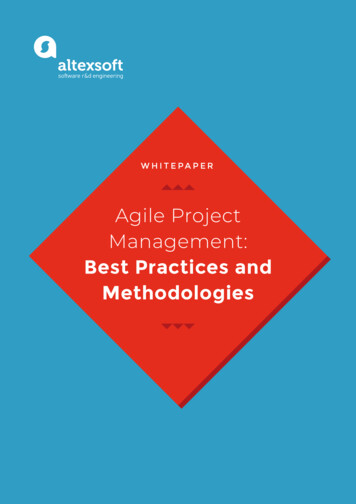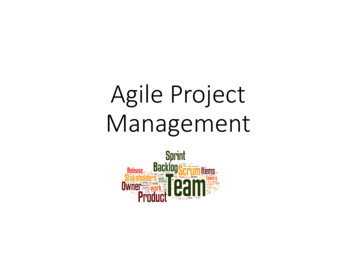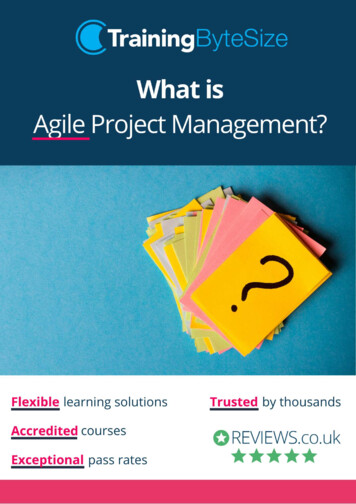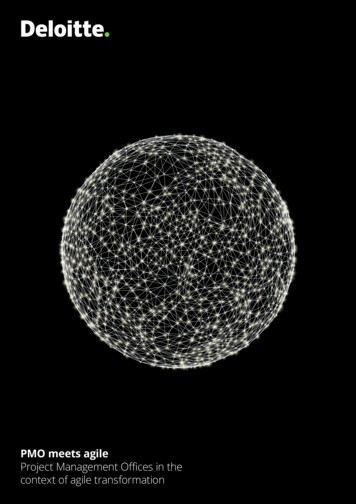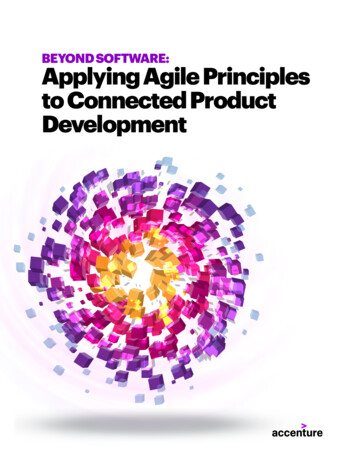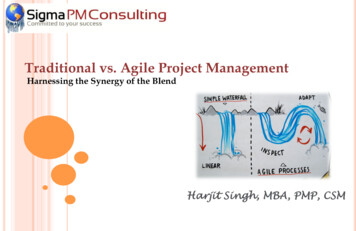
Transcription
Traditional vs. Agile Project ManagementHarnessing the Synergy of the BlendHarjit Singh, MBA, PMP, CSM
OUTLINEWhat is like spinning the wheels in mud? Traditional Project Management (TPM) Model Agile Project Management (APM) Model Waterfall versus Agile Hybrid Model Case Study Copyright – Sigma PM Consulting DO NOT Duplicate2
SPINNING THE WHEELS Copyright – Sigma PM Consulting DO NOT Duplicate3
TRADITIONAL PROJECT MANAGEMENT (TPM)MODEL“Plan the work and work the plan” Define ObjectivesIdentifyStakeholdersDefine DeliverablesDefineAssumptions &ConstraintsInitiation Planning Define workactivitiesEstimate taskdurationsEstimate resourcesEstablish baselineusing above info Perform plannedwork activitiesCollect/log workperformance data Monitor &ControlExecution Ensure projectwork is completedor officiallyterminatedEnsure accountsare paid offArchive documentsCollect lessonslearnedClosingMonitor theprogress of workperformedMonitor theprogress of workperformersInitiate changerequests if needed Copyright – Sigma PM Consulting DO NOT Duplicate4
AGILE PROJECT MANAGEMENT (APM) MODELSprints or Iterations 1, 2, ., N Copyright – Sigma PM Consulting DO NOT Duplicate5
AGILE PROJECT MANAGEMENT (APM) MODELIteration 1, 2, ., NExecutionInitiationMonitor& ControlPlanningFinalClosingClosing Copyright – Sigma PM Consulting DO NOT Duplicate6
SYSTEM/SOFTWARE DEVELOPMENT LIFECYCLE (SDLC) OR WATERFALL VS. AGILE Copyright – Sigma PM Consulting DO NOT Duplicate7
SYSTEM/SOFTWARE DEVELOPMENT LIFECYCLE (SDLC) OR WATERFALL VS. AGILE Copyright – Sigma PM Consulting DO NOT Duplicate8
WATERFALL OR AGILE? Thetwo approachesare not alwaysmutually-exclusive asthought by mostpeople. A blended approachcan bring synergyutilizing best of bothworlds.? Copyright – Sigma PM Consulting DO NOT Duplicate9
WHY AGILE? Copyright – Sigma PM Consulting DO NOT Duplicate10
WHY AGILE? (CONTD.) Adaptability Time-to-market Reducedcosts Customer satisfaction Copyright – Sigma PM Consulting DO NOT Duplicate11
ACTIVITY (10 MINUTES DOING 10 MINUTESDISCUSSING Samjust got hired by KB Homesto manage a large projectinvolving construction of 120 newhomes. Help him decide whetherhe should use pure traditional,pure agile, or a hybrid PMapproach. Why and how? Copyright – Sigma PM Consulting DO NOT Duplicate12
TPM MODEL APPLICATIONS TPMwhenModel is typically used aproject is relatively familiar. it is easy to define project goalsand solution. it is easy to define clear scope anddeliverables. Copyright – Sigma PM Consulting DO NOT Duplicate13
APM MODEL APPLICATIONS APMModel is typically used whena project is relatively unfamiliar. the solution is unknown. there are more than one outcomes. there is direct alignment betweenbusiness and development strategies(e.g., in a business environmentwhere software developmentdominates). Copyright – Sigma PM Consulting DO NOT Duplicate14
ACTIVITY 10Minutes Quiz Copyright – Sigma PM Consulting DO NOT Duplicate15
TPM-APM HYBRID MODEL The hybrid approach can helpduring transition from thetraditional model to the Agilemodel.In a business environmentwhere the alignment betweenbusiness and developmentstrategies is less direct, ahybrid or blended approachmay be more appropriate. Traditional(plan-driven)approach at the higher levelsfollowed by the Agileapproach. Copyright – Sigma PM Consulting DO NOT Duplicate16
HOW TO ACHIEVE THE HYBRID SYNERGY? Maximize business value by bringing minimal viableproduct to the market more quickly. Forlarge infrastructure projects including bothhardware and software development, produce tangibleusable work products frequently.Let customers experience the incremental productsand provide feedback; be adaptive to changes. Empower teams to self-manage as much as possible. Keep customers engaged throughout the project ifand as much as possible. Reduce waste by eliminating unnecessarydocumentation and reducing time to documentreview and approval cycle. Copyright – Sigma PM Consulting DO NOT Duplicate17
HYBRID APPROACH – REAL-LIFE APPLICATION:CALTECH Copyright – Sigma PM Consulting DO NOT Duplicate18
CASE STUDY: HYBRID WATERFALL-AGILEMETHODOLOGY Client:United States FederalAgency Project: Design, Development, andImplementation of WorkflowApplications to Increase Efficiency ofAgency’s Business Processes Copyright – Sigma PM Consulting DO NOT Duplicate19
BACKGROUND Historically, the U.S. federal government large softwaredevelopment projects must meet a predetermined list ofrequirements.Development of these applications followed a traditionalWaterfall approach with requirements and system designbeing delivered upfront.Throughout the development lifecycle, standard Waterfalldocumentation was required for monitoring progress.Development occurred with little if any input from endusers.A final release would then be deployed with plans forapplication maintenance, but few plans for applicationupgrades or modifications.This system led to a number of application failures anddissatisfied end-users. Copyright – Sigma PM Consulting DO NOT Duplicate20
HYBRID APPROACH Two development process levels Waterfall: Designed to meet all governmentrequirementsAgile: Applications development by private contractorWork in the Agile environment is bubbled up everyquarter into a new release that is deployed into theclient's production environmentChallenges using Agile in government environmentbut benefits outweigh the challengesBenefits: Quick deployment of new functionalitiesand enthusiastic end-user involvement Copyright – Sigma PM Consulting DO NOT Duplicate21
TEAM STRUCTURE Two three distinct, but overlapping teams:Program management teamDevelopment teamSocialization team Eachteam is empowered to self-organizeand make decisions regarding theiractivities. End-user representation is present in allteams and is integrated into daily activities Copyright – Sigma PM Consulting DO NOT Duplicate22
PROGRAM MANAGEMENT TEAM Responsiblefor traditional programmanagement activities. These include: Management of all team activitiesCoordinating interaction between theteams and the clientDevelopment and maintenance of allprogram documentationCreation of Waterfall deliverablesVerification that contractualrequirements are met Copyright – Sigma PM Consulting DO NOT Duplicate23
DEVELOPMENT TEAM Responsiblefor actual coding of theapplication and unit testing Most development activities are Agilein nature including daily scrummeetings. However, the developmentteam is also responsible for thecompletion of the System DesignDocument required by Waterfall andsupports the creation of documentsrequired by the federal InfrastructureChange Control Board. Copyright – Sigma PM Consulting DO NOT Duplicate24
SOCIALIZATION TEAM Responsiblefor interacting with endusers. Interactions include: Presenting application briefings toagency leadershipResponding to user questionsTroubleshooting user issuesCreating user materials such as theapplication user guideTraining users Copyright – Sigma PM Consulting DO NOT Duplicate25
METHODOLOGY Copyright – Sigma PM Consulting DO NOT Duplicate26
METHODOLOGY (CONTD.) Thefirst level (waterfall) used tomeet all requirements (for eachrelease, not for each sprint) The second level (Agile) used fordesign and development ofapplications The final stage (maintain) is ongoingand used for requirements gathering Copyright – Sigma PM Consulting DO NOT Duplicate27
OVERALL PROCESS FLOW Four quarterly releasesEach release is composed of six two-week sprintsPrior to beginning sprint 1, requirements are translated into user stories andentered into our backlogThe backlog is then prioritized by the Product OwnerThe Agile development team then evaluates the prioritized backlog and slatesuser stories for each sprint within the releaseAgile methods are then utilized for the completion of six sprints, with eachsprint resulting in a functional build of the applicationEach build is deployed in the test environment and tested by the ProductOwner, team members, and select end-users. Test results are then compiledand user feedback is incorporated into the next sprintAt the end of sprint 6, a final build is subjected to extensive system testingWhen complete, required documentation is updated by the programmanagement teamOnce accepted, the build is then deployed into the federal staging environment Copyright – Sigma PM Consulting DO NOT Duplicate28
ACTIVITY (20 MINUTES) Youare program manager for alarge and complicated globalinfrastructure refresh effort forHewlett-Packard’s productmanufacturing units. You have touse the hybrid Waterfall-Agilemethodology. How can youimplement this methodology? Defineend-to-end hybrid process flow. Copyright – Sigma PM Consulting DO NOT Duplicate29
REFERENCE: FULL CASE STUDY l-agile-development-federal-space-6089 Copyright – Sigma PM Consulting DO NOT Duplicate30
The Agile development team then evaluates the prioritized backlog and slates user stories for each sprint within the release ! Agile methods are then utilized for the completion of six sprints, with each sprint resulting in a functional build of the application ! Each build is d
